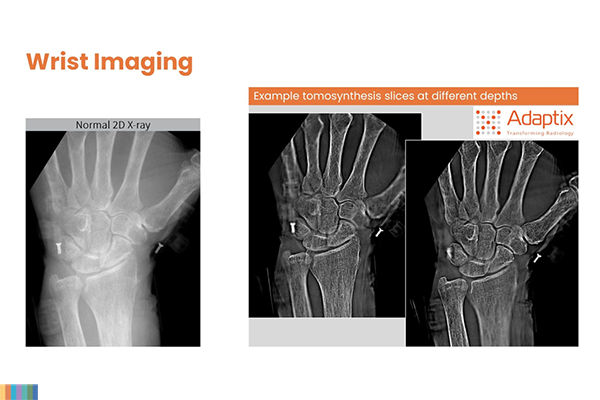AI adds a third dimension to mobile X-Ray, offering more accurate diagnosis

The Liverpool City Region (LCR) AI Summit will show the potential of this disruptive technology
40 per cent of scaphoid bone fractures in the wrist are missed in a 2D x-ray, sometimes resulting in permanent damage for the sufferer and litigation for the hospital. Now a new 3D x-ray technology from Adaptix has potential to cost-effectively provide greater visibility for a more accurate diagnosis, using powerful computing and simulations. The company is looking to extend its imaging to chest x-rays with the help of the Liverpool Centre for Doctoral Training for Innovation in Data Intensive Science (LIV.INNO), just one of the exciting AI projects emerging from Liverpool.
The potential of AI for med-tech is to feature at the Liverpool City Region (LCR) AI Summit on 21 November 2024 and Dr Alexander Hill of LIV.INNO is taking part in the ‘Meet the Innovators’ session.
Steve Rotheram, Mayor of the Liverpool City Region, says: “The Liverpool City Region has always been a place of pioneers, and we’re leading the charge in one of the most exciting areas of modern technology – Artificial Intelligence.
“This AI summit isn’t just about showcasing the amazing talent and innovations happening right here; it’s about making sure that AI works for everyone.
“From healthcare to education, AI has the potential to transform lives, and we’re committed to using it as a force for good. But it’s vital that we steer this technology in the right direction – ensuring it’s ethical, fair, and benefits people across the UK, not just in Silicon Valley or big tech hubs.
“This summit is a chance to put the Liverpool City Region on the map as a global leader in AI for Good, while driving the national conversation on how we can use this transformative technology to build a better future for all of us.”
Professor Carsten P Welsch, Director of LIV.INNO, agrees. PhD students from the centre support industry with bespoke projects – offering specialist skills in prediction, risk analysis, visualisation, and modelling of scenarios. He says: “There is a shortage of skills in AI; our demanding industry projects enable the co-development of solutions to intractable problems, creating competitive advantage for the companies and invaluable commercial skills and experience for our staff and students.”
The development of imaging technology with Adaptix is a good example of this, as Dr Steve Wells, Chief Technical Officer at Adaptix, explains: “2D x-rays are a bit like a shadow puppet – everything is superimposed, so it is difficult to understand in detail what is really going on. CT (computed tomography) and MRI (magnetic resonance imaging) provide much better images, but they are expensive and, in the case of CT, also delivers a much higher dose of radiation.
“The challenge is how to provide cost-effective, high resolution 3D images with a mobile scanner that delivers a low dose of radiation.”
Dr Wells has been working with the team headed up by Professor Carsten P Welsch at the University of Liverpool to develop scanners that fire x-rays from an array of positions to do this.
The Adaptix technology uses digital tomosynthesis, where x-rays are fired sequentially from many angles in order to create slices through the object at different depths. From this, anatomy in 3D can be visualized, with an order of magnitude less radiation than a conventional CT-scan.
The potential of the 3-D scanner has already been recognised by the NHS.
Dr Wells’ team has recently been to the Isles of Scilly to investigate the potential of a mobile scanner for remote communities.
Dr Wells continues: “Scaphoid injuries are commonly caused when you try and save yourself from a fall with an open hand. If someone falls on one of the little islands they need to take a boat to the main island – and the radiographer is only there on a Thursday!
“A scanner that could be used by a specially-trained paramedic would save the cost of flying someone to the mainland and enable much more rapid treatment.”
The technology is producing images that have been well received by radiologists and the company is working on regulatory approvals.
The wider Liverpool City Region also has specialisms in accelerator science, the creative industries, infection medicine, novel materials, and advanced manufacturing – offering potential for a dynamic innovation ecosystem aimed at solving societal challenges.
Students at LIV.INNO receive a comprehensive training in data-intensive science in areas such as nuclear, particle and accelerator physics, developing their knowledge of AI, machine learning, data analysis and the Monte Carlo method for modelling. They then apply their skills to address commercial challenges.
LIV.INNO has just been awarded £400k from STFC to design a new system for chest imaging. The project will use AI and Machine Learning techniques, developed by students and staff from LIV.INNO.
Liverpool City Region AI Summit takes place on 21st November at BOXPARK, Liverpool L8 5XJ.